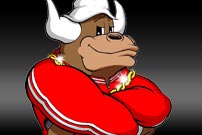 With the temperature dropping, it's time to find someone to keep you warm. Find your hookups with our online dating guide!
With the temperature dropping, it's time to find someone to keep you warm. Find your hookups with our online dating guide!

Music Home / Entertainment Channel / Bullz-Eye Home
Yes, we know that writing about music is like dancing about architecture (even if we’re not convinced that Elvis Costello said it first), but let’s be realistic: if you’re a music fan who likes to read, you can achieve a very special level of bliss when you get the opportunity to dive into a book about music. The Bullz-Eye staff knocked their heads together and came up with a list of 45 books that span several musical genres and include autobiographies and biographies, histories of record companies and music magazines, essay collections, and straight-up reference tomes. It’s not intended to be all-encompassing, nor would we presume to call it a definitive list of the best music books of all time. It’s simply a selection of some of our personal favorites, none of which would be out of place on a music fan’s bookshelf.
 The All Music Guide to Rock: The Definitive Guide to Rock, Pop and Soul, edited by Stephen Thomas Erlewine, Chris Woodstra and Vladimir Bogdanov
The All Music Guide to Rock: The Definitive Guide to Rock, Pop and Soul, edited by Stephen Thomas Erlewine, Chris Woodstra and Vladimir Bogdanov
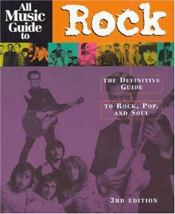 It’s doubtful that there will ever really be a “definitive” guide/book of rock album reviews, but this tome certainly is one of the most even-handed and fair. In addition to the musical critiques, the “All Music Guide” has always been about giving readers a healthy dose of capsulated, but informative, histories of the artists and bands it covers. This book continues to work in that direction, and manages to be entertaining without being too kiss-ass to the classics, though it’s worth noting that Chris Butler (of Waitresses fame) once personally told me that AMG writer Chris Woodstra didn’t know what the hell he was talking about when it came to his band’s second album, Bruiseology. But, hey, no critic is infallible. If you’re in the market to buy an album guide, this one’s well worth your time and money. It’s not quite as all-encompassing as the website – the invaluable AllMusic.com – but at least you don’t have to deal with the hassle of slow page loads and busy servers.
It’s doubtful that there will ever really be a “definitive” guide/book of rock album reviews, but this tome certainly is one of the most even-handed and fair. In addition to the musical critiques, the “All Music Guide” has always been about giving readers a healthy dose of capsulated, but informative, histories of the artists and bands it covers. This book continues to work in that direction, and manages to be entertaining without being too kiss-ass to the classics, though it’s worth noting that Chris Butler (of Waitresses fame) once personally told me that AMG writer Chris Woodstra didn’t know what the hell he was talking about when it came to his band’s second album, Bruiseology. But, hey, no critic is infallible. If you’re in the market to buy an album guide, this one’s well worth your time and money. It’s not quite as all-encompassing as the website – the invaluable AllMusic.com – but at least you don’t have to deal with the hassle of slow page loads and busy servers.
– Jason Thompson
 And I Don’t Want To Live This Life: A Mother’s Story of Her Daughter’s Murder, by Deborah Spungen
And I Don’t Want To Live This Life: A Mother’s Story of Her Daughter’s Murder, by Deborah Spungen
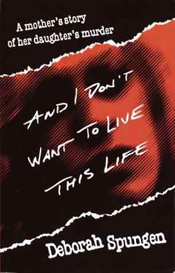 Less a music-related book than a tale of a family being torn apart by one its own members, “And I Don’t Want To Live This Life” nonetheless succeeds in providing great insight into one of the most infamous rock ‘n’ roll romances of all time. Most punk rock fans worth their salt have seen Alex Cox’s film, “Sid and Nancy,” and if you count yourself among that number, we’ll forgive you for thinking that Nancy was nothing but a stupid, whiny, loudmouthed, heroin-shooting groupie who got what was coming to her. After reading her mother’s memoir, however, you may be surprised to find yourself viewing Nancy as a tragic figure who battled mental illness (schizophrenia, to be specific) and forced her family to endure years of emotional torture long before heroin -- let alone a certain bass-playing Brit -- ever entered the picture. (Indeed, Mr. Vicious doesn’t emerge as a major character until the final third of the book.) This is a heart-wrenching read, written by a parent who knew her daughter was doomed to die young, yet found she could do precious little to prevent it. Nancy herself once said, “I could have been a ward of the state; I had, like, a lotta problems,” but until you’ve read “And I Don’t Want To Live This Life,” you can’t comprehend just how big an understatement that was. – Will Harris
Less a music-related book than a tale of a family being torn apart by one its own members, “And I Don’t Want To Live This Life” nonetheless succeeds in providing great insight into one of the most infamous rock ‘n’ roll romances of all time. Most punk rock fans worth their salt have seen Alex Cox’s film, “Sid and Nancy,” and if you count yourself among that number, we’ll forgive you for thinking that Nancy was nothing but a stupid, whiny, loudmouthed, heroin-shooting groupie who got what was coming to her. After reading her mother’s memoir, however, you may be surprised to find yourself viewing Nancy as a tragic figure who battled mental illness (schizophrenia, to be specific) and forced her family to endure years of emotional torture long before heroin -- let alone a certain bass-playing Brit -- ever entered the picture. (Indeed, Mr. Vicious doesn’t emerge as a major character until the final third of the book.) This is a heart-wrenching read, written by a parent who knew her daughter was doomed to die young, yet found she could do precious little to prevent it. Nancy herself once said, “I could have been a ward of the state; I had, like, a lotta problems,” but until you’ve read “And I Don’t Want To Live This Life,” you can’t comprehend just how big an understatement that was. – Will Harris
 The Beatles Forever, by Nicholas Shaffner
The Beatles Forever, by Nicholas Shaffner
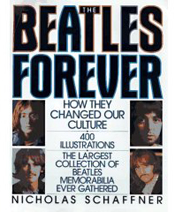 The problem with Beatles books is that there are just so darned many of them, encompassing every possible reading level and written by everyone from the band’s former chauffeur to the Fab Four themselves. In the end, we went with a sentimental choice -- and by “we,” I really mean “I.” Call it a case of unabashed editorial discretion if you must: “The Beatles Forever” was my personal bible while I immersed myself in their music during my teen years. But it’s far from a stretch to suggest that the late Mr. Shaffner’s book is, even three decades from its first printing, still an absolute must-own for fans of the band. In addition to his captivating history of The Beatles, placed in the proper historical context so as to clarify just how much they changed the world, there are a ton of photos of the guys that you’ve likely never seen before (Hey, look, there’s John and Yoko hanging with James Taylor, Carly Simon and Muhammad Ali!) as well as fascinating photographic glimpses at merchandise, memorabilia, and books and magazines dedicated to the group. Probably the best bit about “The Beatles Forever,” though, is that it was written at a time when all four members of the band were still alive -- which means that, even as the last page is turned, you’re still left with the unmistakable sensation that maybe The Beatles could still get back together someday. Be sure to hold on to that feeling for as long as you can. – Will Harris
The problem with Beatles books is that there are just so darned many of them, encompassing every possible reading level and written by everyone from the band’s former chauffeur to the Fab Four themselves. In the end, we went with a sentimental choice -- and by “we,” I really mean “I.” Call it a case of unabashed editorial discretion if you must: “The Beatles Forever” was my personal bible while I immersed myself in their music during my teen years. But it’s far from a stretch to suggest that the late Mr. Shaffner’s book is, even three decades from its first printing, still an absolute must-own for fans of the band. In addition to his captivating history of The Beatles, placed in the proper historical context so as to clarify just how much they changed the world, there are a ton of photos of the guys that you’ve likely never seen before (Hey, look, there’s John and Yoko hanging with James Taylor, Carly Simon and Muhammad Ali!) as well as fascinating photographic glimpses at merchandise, memorabilia, and books and magazines dedicated to the group. Probably the best bit about “The Beatles Forever,” though, is that it was written at a time when all four members of the band were still alive -- which means that, even as the last page is turned, you’re still left with the unmistakable sensation that maybe The Beatles could still get back together someday. Be sure to hold on to that feeling for as long as you can. – Will Harris
 Before I Get Old: The Story of the Who, by Dave Marsh
Before I Get Old: The Story of the Who, by Dave Marsh
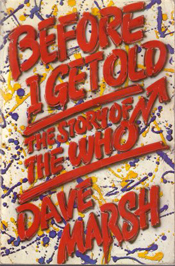 Simply put, the best biography of the best band to come out of the British Invasion. Marsh doesn’t pull punches or mince words: All of Pete Townshend’s genius (“Tommy”) and pretentiousness (“Lifehouse”) comes shining through, for instance, and Marsh doesn’t sugarcoat the fact that The (real) Who died with Keith Moon. The in-depth research into the early years of each individual band member, not to mention the captivating minutia of the pre-Who years, will clarify a lot about the inner workings of the entire Who camp. Also included are insights into the whole Mod Scene, and solid info on such factoids as how the band (and especially Entwistle) was involved with the creation of Marshall amplifiers during the early- to-mid-‘60s. A little clinical at times, and too self-important for its own good (not to mention Marsh’s predilection for all things Townshend), “Before I Get Old” nonetheless is a solid (if too journalistic) in-depth account of one hell of a band. – Una Persson
Simply put, the best biography of the best band to come out of the British Invasion. Marsh doesn’t pull punches or mince words: All of Pete Townshend’s genius (“Tommy”) and pretentiousness (“Lifehouse”) comes shining through, for instance, and Marsh doesn’t sugarcoat the fact that The (real) Who died with Keith Moon. The in-depth research into the early years of each individual band member, not to mention the captivating minutia of the pre-Who years, will clarify a lot about the inner workings of the entire Who camp. Also included are insights into the whole Mod Scene, and solid info on such factoids as how the band (and especially Entwistle) was involved with the creation of Marshall amplifiers during the early- to-mid-‘60s. A little clinical at times, and too self-important for its own good (not to mention Marsh’s predilection for all things Townshend), “Before I Get Old” nonetheless is a solid (if too journalistic) in-depth account of one hell of a band. – Una Persson
 Big Star: The Short Life, Painful Death, and Unexpected Resurrection of the Kings of Power Pop, by Rob Jovanovic
Big Star: The Short Life, Painful Death, and Unexpected Resurrection of the Kings of Power Pop, by Rob Jovanovic
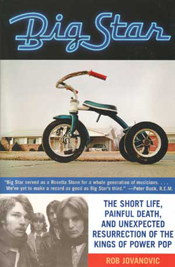 If there’s a more comprehensive telling of the Big Star story, I have yet to come across it. I don’t think it’s possible, quite frankly. Author Jovanovic digs down to the almost subatomic level here, with musical histories of musicians only fleetingly connected to these power-pop iconoclasts. He includes an exhaustive discography, concert list and cataloging of Big Star songs covered by other bands. Most importantly, though, Jovanovic is able to weave all the various strands, influences and personalities that made Big Star special in the first place. Their almost-unlimited access to Ardent Studios in their hometown of Memphis, for instance, is a crucial component of why their albums sound so damn good, even 30+ years on. Musical cultists and hipsters alike love to name-drop Big Star, which in and of itself is fascinating. But I defy anyone to read this book and not rush right out to purchase and begin obsessing over all three of their albums, if not anything remotely associated with this legendary band.
If there’s a more comprehensive telling of the Big Star story, I have yet to come across it. I don’t think it’s possible, quite frankly. Author Jovanovic digs down to the almost subatomic level here, with musical histories of musicians only fleetingly connected to these power-pop iconoclasts. He includes an exhaustive discography, concert list and cataloging of Big Star songs covered by other bands. Most importantly, though, Jovanovic is able to weave all the various strands, influences and personalities that made Big Star special in the first place. Their almost-unlimited access to Ardent Studios in their hometown of Memphis, for instance, is a crucial component of why their albums sound so damn good, even 30+ years on. Musical cultists and hipsters alike love to name-drop Big Star, which in and of itself is fascinating. But I defy anyone to read this book and not rush right out to purchase and begin obsessing over all three of their albums, if not anything remotely associated with this legendary band.
– Una Persson
 Blue Monday: Fats Domino and the Lost Dawn of Rock ‘n’ Roll, by Rick Coleman
Blue Monday: Fats Domino and the Lost Dawn of Rock ‘n’ Roll, by Rick Coleman
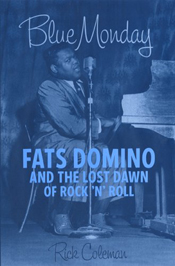 Fats Domino is an interesting and often overlooked figure in rock ‘n’ roll history. There’s one generation that knows him more for Richie Cunningham’s regular quoting from “Blueberry Hill” than for his music, while kids today only became aware of him in the wake of Hurricane Katrina, when he was briefly feared to have perished amongst the devastation. Even those who thrilled to songs like “Ain’t That a Shame” and “I’m Walkin’” during their original chart reign, however, may not be aware of just how much Fats’ earlier piano-pounding tunes helped set the stage for the rise of rock. Coleman’s exhaustive research on his subject is evident on every page, with quotes from those who have worked with Domino throughout his long (and still ongoing) career, following his story from his familial origins all the way up to his initial post-Katrina experiences. There’s a little boozing here, a little womanizing there, and plenty of tremendously detailed examinations of the music industry from the late 1940s onward. Most impressive is the insight Coleman provides into just how many race barriers were broken by “The Fat Man” along the way. – Will Harris
Fats Domino is an interesting and often overlooked figure in rock ‘n’ roll history. There’s one generation that knows him more for Richie Cunningham’s regular quoting from “Blueberry Hill” than for his music, while kids today only became aware of him in the wake of Hurricane Katrina, when he was briefly feared to have perished amongst the devastation. Even those who thrilled to songs like “Ain’t That a Shame” and “I’m Walkin’” during their original chart reign, however, may not be aware of just how much Fats’ earlier piano-pounding tunes helped set the stage for the rise of rock. Coleman’s exhaustive research on his subject is evident on every page, with quotes from those who have worked with Domino throughout his long (and still ongoing) career, following his story from his familial origins all the way up to his initial post-Katrina experiences. There’s a little boozing here, a little womanizing there, and plenty of tremendously detailed examinations of the music industry from the late 1940s onward. Most impressive is the insight Coleman provides into just how many race barriers were broken by “The Fat Man” along the way. – Will Harris
 Bomp!: Saving the World One Record at a Time, by Suzy Shaw and Mick Farren
Bomp!: Saving the World One Record at a Time, by Suzy Shaw and Mick Farren
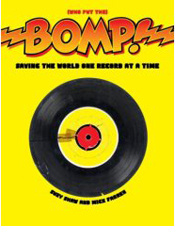 This “yearbook-sized” hardcover tells the story of Bomp!, an independent record label, record store, mail order (and now online) record outlet, magazine and life-work of owner/genius Greg Shaw. Lovingly compiled by Greg’s life and business partner (and ex-wife) Suzy Shaw, and co-edited by Mick Farren, the book is a smorgasbord of creativity, with generous helpings of artwork, memorabilia, plenty of anecdotes, and some fantastic rock journalism by some of rock’s best writers. These include Farren, Greil Marcus, Lester Bangs (whose legendary “James Taylor Marked for Death” essay is reprinted here in its entirety), Lenny Kaye, and Greg Shaw himself. You get archival material – such as articles and features from Shaw’s pre-Bomp! ‘zine “Mojo Navigator” (which featured the first published interview with The Doors, also reprinted here), and the renowned lost and previously unpublished “Issue #22” of the magazine - along with new essays that put the entire project in perspective. In short, “Bomp!: Saving the World One Record at a Time,” tells the story of rock ‘n’ roll better than any biography or other rock treatise you’re likely to read. – Una Persson
This “yearbook-sized” hardcover tells the story of Bomp!, an independent record label, record store, mail order (and now online) record outlet, magazine and life-work of owner/genius Greg Shaw. Lovingly compiled by Greg’s life and business partner (and ex-wife) Suzy Shaw, and co-edited by Mick Farren, the book is a smorgasbord of creativity, with generous helpings of artwork, memorabilia, plenty of anecdotes, and some fantastic rock journalism by some of rock’s best writers. These include Farren, Greil Marcus, Lester Bangs (whose legendary “James Taylor Marked for Death” essay is reprinted here in its entirety), Lenny Kaye, and Greg Shaw himself. You get archival material – such as articles and features from Shaw’s pre-Bomp! ‘zine “Mojo Navigator” (which featured the first published interview with The Doors, also reprinted here), and the renowned lost and previously unpublished “Issue #22” of the magazine - along with new essays that put the entire project in perspective. In short, “Bomp!: Saving the World One Record at a Time,” tells the story of rock ‘n’ roll better than any biography or other rock treatise you’re likely to read. – Una Persson
 Can’t Stop Won’t Stop, by Jeff Chang
Can’t Stop Won’t Stop, by Jeff Chang
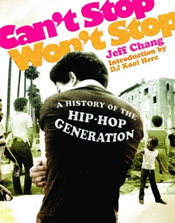 Jeff Chang’s thorough history of hip-hop, “Can't Stop Won't Stop” is impressive in its depth and range. Chang touches upon the genres’ aesthetics and its key players, from the now infamous parties in the Bronx with DJ Cool Herc, through the rise and fall of Public Enemy and the anger of Ice Cube. But this is just as much a history lesson in regards to the socio-economic influences that shaped rap. The historic focus is far more studious than one might expect, and as a result, everyone who reads this will come out of it all the wiser in regards to where rap’s violent tendencies come from. Chang traces a path full of tension through fires and gang wars in the Bronx, the riots in Howard Beach and the shooting of Latasha Harlins. In examining the sources of inspiration for the music, he also unveils the forces behind hip-hop’s associated sub-cultures, like graffiti and break dancing. As happens with any burgeoning music genre, a clear picture is also provided of how hip-hop was so quickly exploited. For any causal fan, it’s a painful revelation to learn that Sugarhill Gang, the first group to produce a Top 40 hip-hop single with “Rapper's Delight,” was actually the result of producers and businessmen looking to manufacture a group that could do just that. A searing and enlightening history, reading “Can't Stop Won't Stop”makes it impossible to listen to rap in the same way. – Taylor Long
Jeff Chang’s thorough history of hip-hop, “Can't Stop Won't Stop” is impressive in its depth and range. Chang touches upon the genres’ aesthetics and its key players, from the now infamous parties in the Bronx with DJ Cool Herc, through the rise and fall of Public Enemy and the anger of Ice Cube. But this is just as much a history lesson in regards to the socio-economic influences that shaped rap. The historic focus is far more studious than one might expect, and as a result, everyone who reads this will come out of it all the wiser in regards to where rap’s violent tendencies come from. Chang traces a path full of tension through fires and gang wars in the Bronx, the riots in Howard Beach and the shooting of Latasha Harlins. In examining the sources of inspiration for the music, he also unveils the forces behind hip-hop’s associated sub-cultures, like graffiti and break dancing. As happens with any burgeoning music genre, a clear picture is also provided of how hip-hop was so quickly exploited. For any causal fan, it’s a painful revelation to learn that Sugarhill Gang, the first group to produce a Top 40 hip-hop single with “Rapper's Delight,” was actually the result of producers and businessmen looking to manufacture a group that could do just that. A searing and enlightening history, reading “Can't Stop Won't Stop”makes it impossible to listen to rap in the same way. – Taylor Long
 Cash: The Autobiography, by Johnny Cash
Cash: The Autobiography, by Johnny Cash
 After decades of exposure to all the fawning praise lavished on him by music critics, a person could be forgiven for believing that God created Johnny Cash on the eighth day, and that he burst fully formed into the world, clad in black, surveying Eden with his withering glare. The truth, obviously, is much more mundane, and Cash lays it all out here, from his early days at Sun Records to his late-period victory lap with Rick Rubin. Cash diehards who were around for his first autobiography, 1986’s “The Man in Black,” may be less than thrilled with the amount of old ground he covers here, but when you’ve lived a life with this many incredible twists, you can certainly be forgiven for re-telling a story or two. Time has only relaxed Cash’s conversational style, deepening the humility that adds a necessary counterpoint to the narcissism that inspires two autobiographies in the first place. It probably doesn’t have enough glitter to make fans out of non-believers, but “Cash”emphatically underscores its author’s deep importance. – Jeff Giles
After decades of exposure to all the fawning praise lavished on him by music critics, a person could be forgiven for believing that God created Johnny Cash on the eighth day, and that he burst fully formed into the world, clad in black, surveying Eden with his withering glare. The truth, obviously, is much more mundane, and Cash lays it all out here, from his early days at Sun Records to his late-period victory lap with Rick Rubin. Cash diehards who were around for his first autobiography, 1986’s “The Man in Black,” may be less than thrilled with the amount of old ground he covers here, but when you’ve lived a life with this many incredible twists, you can certainly be forgiven for re-telling a story or two. Time has only relaxed Cash’s conversational style, deepening the humility that adds a necessary counterpoint to the narcissism that inspires two autobiographies in the first place. It probably doesn’t have enough glitter to make fans out of non-believers, but “Cash”emphatically underscores its author’s deep importance. – Jeff Giles
 Catch a Fire: The Life of Bob Marley, by Timothy White
Catch a Fire: The Life of Bob Marley, by Timothy White
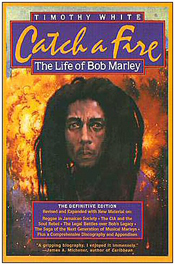 Bob Marley remains a mythic figure, one of the few stars who transcended music to put their stamp on the world at large. Former “Billboard” editor and eminent rock journalist Timothy White tackles this story in “Catch a Fire,” a necessarily wide-ranging work that looks at the history of Jamaican and world politics; the religion of Rastafarianism; the cult of marijuana; and the evolution of ska and reggae music from its beginnings with the roving sound systems (giant speakers on flat-bed trucks) and toasting contests (an early form of rapping). All this goes to frame the life of Marley, a Jamaican street tough who grew up to influence entire nations. White interviewed Marley many times, as well as friends, family, band members and experts, to create a well-rounded portrait. This is an even more impressive accomplishment considering the paucity of documentation on the island nation. Even basic facts such as when Marley was born cannot be accurately nailed down. But, as Marley himself memorably puts it, “facts an’ facts, an’ t’ings an’ t’ings, dem’s a lotta fockin’ bullshit.” Indeed, the real story here is Marley himself, his philosophy and his music and his life, from making his first records, to fathering whole villages of children, to being shot, and refusing life-saving treatment for the cancer which eventually killed him. White even details the fight among Marley’s family over his estate. There’s almost too much to take in here in one reading, a sure sign that the author has more than done his job. – Jim Washington
Bob Marley remains a mythic figure, one of the few stars who transcended music to put their stamp on the world at large. Former “Billboard” editor and eminent rock journalist Timothy White tackles this story in “Catch a Fire,” a necessarily wide-ranging work that looks at the history of Jamaican and world politics; the religion of Rastafarianism; the cult of marijuana; and the evolution of ska and reggae music from its beginnings with the roving sound systems (giant speakers on flat-bed trucks) and toasting contests (an early form of rapping). All this goes to frame the life of Marley, a Jamaican street tough who grew up to influence entire nations. White interviewed Marley many times, as well as friends, family, band members and experts, to create a well-rounded portrait. This is an even more impressive accomplishment considering the paucity of documentation on the island nation. Even basic facts such as when Marley was born cannot be accurately nailed down. But, as Marley himself memorably puts it, “facts an’ facts, an’ t’ings an’ t’ings, dem’s a lotta fockin’ bullshit.” Indeed, the real story here is Marley himself, his philosophy and his music and his life, from making his first records, to fathering whole villages of children, to being shot, and refusing life-saving treatment for the cancer which eventually killed him. White even details the fight among Marley’s family over his estate. There’s almost too much to take in here in one reading, a sure sign that the author has more than done his job. – Jim Washington
 Chronicles, Volume One, by Bob Dylan
Chronicles, Volume One, by Bob Dylan
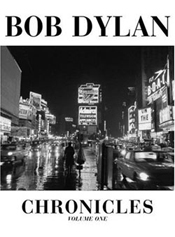 There have been loads of books written about Bob Dylan, yet it wasn’t until 2004 that the man himself told his own story on his own terms. And, in typical Dylan fashion, he defied desires and expectations when his long-awaited “autobiography” finally surfaced. At a terse 293 pages, “Chronicles, Volume One” – with its teaser of a title and no firm promise of future volumes to come – is far from the revealing, myth-busting, tell-all autobiography that one would hope for. In fact, the book is just as notable for the kinds of details it completely ignores (Dylan’s drug-fueled cultural and artistic peak of ’65-’66 and subsequent motorcycle crash, his divorce from Sara Dylan, his conversion to Christianity) than for what he does cover. I mean, how many people besides hard-core Dylan-philes were just itching to hear about the creative process behind 1989’s critically acclaimed Oh Mercy, for instance? Dylan’s reaction to what Daniel Lanois was trying to extract from Dylan at that time (“he was looking for songs that define me as a person”) applies to this book as well: “there’s just too much small print in thousands of pages for anything like that to happen.” And clearly, Dylan is only committed to revealing so much of himself. But regardless of his choices of life events to focus on, and regardless of the fact that the chapters don’t follow a strict chronological timeline, “Chronicles” is filled with brilliant storytelling, which has always been one of Dylan’s strengths.
There have been loads of books written about Bob Dylan, yet it wasn’t until 2004 that the man himself told his own story on his own terms. And, in typical Dylan fashion, he defied desires and expectations when his long-awaited “autobiography” finally surfaced. At a terse 293 pages, “Chronicles, Volume One” – with its teaser of a title and no firm promise of future volumes to come – is far from the revealing, myth-busting, tell-all autobiography that one would hope for. In fact, the book is just as notable for the kinds of details it completely ignores (Dylan’s drug-fueled cultural and artistic peak of ’65-’66 and subsequent motorcycle crash, his divorce from Sara Dylan, his conversion to Christianity) than for what he does cover. I mean, how many people besides hard-core Dylan-philes were just itching to hear about the creative process behind 1989’s critically acclaimed Oh Mercy, for instance? Dylan’s reaction to what Daniel Lanois was trying to extract from Dylan at that time (“he was looking for songs that define me as a person”) applies to this book as well: “there’s just too much small print in thousands of pages for anything like that to happen.” And clearly, Dylan is only committed to revealing so much of himself. But regardless of his choices of life events to focus on, and regardless of the fact that the chapters don’t follow a strict chronological timeline, “Chronicles” is filled with brilliant storytelling, which has always been one of Dylan’s strengths.
– Michael Fortes
 C’mon, Get Happy: Fear and Loathing on the Partridge Family Bus, by David Cassidy
C’mon, Get Happy: Fear and Loathing on the Partridge Family Bus, by David Cassidy
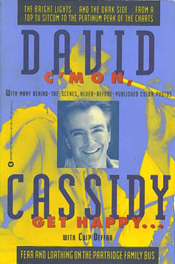 The most interesting chapters in David Cassidy’s autobiography are those dealing with the business of taking a kid and turning him into the biggest money-making music star on the planet. In four short years, Cassidy broke worldwide record sales and concert attendance records that had been held by such legends as Elvis Presley and The Beatles. The sad, shocking part is that it could have been anyone, as long as they had some talent, good looks, the luck to be cast as Keith Partridge, and, most importantly, the ability to do what they’re told. “C’mon, Get Happy” details a business and marketing plan that was perfected with Cassidy, and continued to produce phenomenal amounts of money in the decades that followed. It can still be seen in action with the boy bands of the ‘90s and the pop tarts of today. (Cassidy’s half-brother, Shaun, was even put through the system.) Of course, all of this is not for the benefit of the artists but, as Cassidy describes it, for enhancing the bottom line of the record company the artist was signed to, and the magazine publishers who ran the fan clubs and glossy teen magazines. When the fans have moved on to the next flavor-of-the-year, the artist is left to his own devices -- usually in debt, having been cheated out of millions along the way. Cassidy spends a great deal of his autobiography on two subjects: his relationship with his father and his life between 1970 and 1974. If you’re interested in his private life, then you have no better place to go for his exploits as a record-breaking pop-star/sex-symbol. Beware of the horrifying Chapter 17, though; I honestly don't know how the guy could live with himself after the events of that weekend. – Mike Connolly
The most interesting chapters in David Cassidy’s autobiography are those dealing with the business of taking a kid and turning him into the biggest money-making music star on the planet. In four short years, Cassidy broke worldwide record sales and concert attendance records that had been held by such legends as Elvis Presley and The Beatles. The sad, shocking part is that it could have been anyone, as long as they had some talent, good looks, the luck to be cast as Keith Partridge, and, most importantly, the ability to do what they’re told. “C’mon, Get Happy” details a business and marketing plan that was perfected with Cassidy, and continued to produce phenomenal amounts of money in the decades that followed. It can still be seen in action with the boy bands of the ‘90s and the pop tarts of today. (Cassidy’s half-brother, Shaun, was even put through the system.) Of course, all of this is not for the benefit of the artists but, as Cassidy describes it, for enhancing the bottom line of the record company the artist was signed to, and the magazine publishers who ran the fan clubs and glossy teen magazines. When the fans have moved on to the next flavor-of-the-year, the artist is left to his own devices -- usually in debt, having been cheated out of millions along the way. Cassidy spends a great deal of his autobiography on two subjects: his relationship with his father and his life between 1970 and 1974. If you’re interested in his private life, then you have no better place to go for his exploits as a record-breaking pop-star/sex-symbol. Beware of the horrifying Chapter 17, though; I honestly don't know how the guy could live with himself after the events of that weekend. – Mike Connolly
 The Complete Rock Family Trees, by Pete Frame
The Complete Rock Family Trees, by Pete Frame
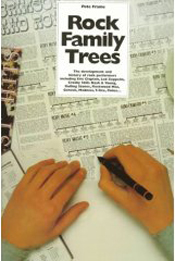 There’s really only one bit of advice you need before approaching the works of Pete Frame: either have a magnifying glass at the ready, or plan on needing glasses more than you probably already do. Frame’s knowledge of how one band connects to another band is more complete than just about any other music historian, and he imparts this information by taking a steady hand and drawing up elaborate family trees in the tiniest of lettering. It’s a bit intimidating when you first take a gander at the pages, given just how much text he manages to pack into each tree, but the trivia bursting from every page quickly proves far too enthralling to deny. “Byrds of a Feather” reveals that Chris Hillman (The Byrds) and Bernie Leadon (The Eagles) were both members of a band called the Scottsville Squirrell Barkers, while “Police Antecedents” offers the revelation that Andy Summers once served as guitarist in an incarnation of Eric Burdon’s New Animals. Alt-rock fans may be amazed to learn in “Liverpool 1980: Eric’s Progeny” about a foursome called The Opium Eaters that consisted of Pete Wylie (The Mighty Wah!), Paul Rutherford (Frankie Goes to Hollywood), Ian Broudie (The Lightning Seeds), and Budgie (Siouxsie and the Banshees). Some trees have more branches than others, but each is still packed sky-high with info. Frame occasionally ventures into unlikely selections, such as his decision to dedicate his time to a history of The Passions (“I’m In Love With A German Film Star”), but no matter what the topic, he always provides something worth learning. In this case, that a member of the group – Clive Timperley – was once in The 101’ers with Joe Strummer. Frame’s “Family Trees” are blindingly good reading, but if you’re reading them in a poorly lit room, the emphasis is most certainly on the “blindingly.”
There’s really only one bit of advice you need before approaching the works of Pete Frame: either have a magnifying glass at the ready, or plan on needing glasses more than you probably already do. Frame’s knowledge of how one band connects to another band is more complete than just about any other music historian, and he imparts this information by taking a steady hand and drawing up elaborate family trees in the tiniest of lettering. It’s a bit intimidating when you first take a gander at the pages, given just how much text he manages to pack into each tree, but the trivia bursting from every page quickly proves far too enthralling to deny. “Byrds of a Feather” reveals that Chris Hillman (The Byrds) and Bernie Leadon (The Eagles) were both members of a band called the Scottsville Squirrell Barkers, while “Police Antecedents” offers the revelation that Andy Summers once served as guitarist in an incarnation of Eric Burdon’s New Animals. Alt-rock fans may be amazed to learn in “Liverpool 1980: Eric’s Progeny” about a foursome called The Opium Eaters that consisted of Pete Wylie (The Mighty Wah!), Paul Rutherford (Frankie Goes to Hollywood), Ian Broudie (The Lightning Seeds), and Budgie (Siouxsie and the Banshees). Some trees have more branches than others, but each is still packed sky-high with info. Frame occasionally ventures into unlikely selections, such as his decision to dedicate his time to a history of The Passions (“I’m In Love With A German Film Star”), but no matter what the topic, he always provides something worth learning. In this case, that a member of the group – Clive Timperley – was once in The 101’ers with Joe Strummer. Frame’s “Family Trees” are blindingly good reading, but if you’re reading them in a poorly lit room, the emphasis is most certainly on the “blindingly.”
– Will Harris
 The Dirt: Confessions of the World's Most Notorious Rock Band,
The Dirt: Confessions of the World's Most Notorious Rock Band,
by Tommy Lee, Mick Mars, Vince Neil, and Nikki Sixx, with Neil Strauss
 Back in his NBC days, when David Letterman would do his Viewer Mail segment, anytime he read a really stupid question from a letter that had more than one signature, he’d look into the camera and make the stunned observation, “It took two people to write this letter.” There’s a similar temptation to mock the fact that it took five people to author “The Dirt,” especially given that the four members of Motley Crue went into the project with no particular writing credits to their name. Fortunately, Neil Strauss – author of “Rules of the Game” – was on hand to keep things orderly. Oh, who are we kidding? Strauss probably wrote 95 percent of this thing. But who cares who wrote it? We knew from the very first paragraph that “The Dirt” was destined to be an all-time classic: “Her name was Bullwinkle. We called her that because she had a face like a moose, but Tommy, even though he could get any girl he wanted on the Sunset Strip, would not break up with her. He loved her and wanted to marry her, he kept telling us, because she could spray her cum across the room.” One paragraph in, and either you’ve thrown the book across the room in disgust or you’ve vowed to keep reading until you’ve absorbed every last word. – Will Harris
Back in his NBC days, when David Letterman would do his Viewer Mail segment, anytime he read a really stupid question from a letter that had more than one signature, he’d look into the camera and make the stunned observation, “It took two people to write this letter.” There’s a similar temptation to mock the fact that it took five people to author “The Dirt,” especially given that the four members of Motley Crue went into the project with no particular writing credits to their name. Fortunately, Neil Strauss – author of “Rules of the Game” – was on hand to keep things orderly. Oh, who are we kidding? Strauss probably wrote 95 percent of this thing. But who cares who wrote it? We knew from the very first paragraph that “The Dirt” was destined to be an all-time classic: “Her name was Bullwinkle. We called her that because she had a face like a moose, but Tommy, even though he could get any girl he wanted on the Sunset Strip, would not break up with her. He loved her and wanted to marry her, he kept telling us, because she could spray her cum across the room.” One paragraph in, and either you’ve thrown the book across the room in disgust or you’ve vowed to keep reading until you’ve absorbed every last word. – Will Harris
 Fargo Rock City: A Heavy Metal Odyssey in Rural North Dakota,
Fargo Rock City: A Heavy Metal Odyssey in Rural North Dakota,
by Chuck Klosterman
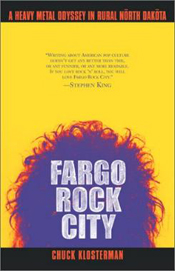 Depending on your taste in overly self-referential pop-culture essayists, Chuck Klosterman is either the greatest thing since Lester Bangs, or an annoying example of everything that’s wrong with modern crit. Love him or hate him, Klosterman has developed a serious following, and although it didn’t start here, it probably marks the spot where things started to snowball for the bespectacled ironist (or is that non-ironist?). Klosterman, as it turns out, was a dedicated heavy metal fan during the genre’s ‘80s salad days, and uses these 288 pages to refract that love through the prism of his rural North Dakota upbringing. Half memoir, half critical retrospective, “Fargo Rock City”helped presage the first nostalgic metal boom of the 21st century, and it’s a damn fine book besides. Hardcore metal fans may come away from the book feeling like Klosterman is more of a smartass than a true aficionado, but they’ll be hard-pressed not to laugh along with him. – Jeff Giles
Depending on your taste in overly self-referential pop-culture essayists, Chuck Klosterman is either the greatest thing since Lester Bangs, or an annoying example of everything that’s wrong with modern crit. Love him or hate him, Klosterman has developed a serious following, and although it didn’t start here, it probably marks the spot where things started to snowball for the bespectacled ironist (or is that non-ironist?). Klosterman, as it turns out, was a dedicated heavy metal fan during the genre’s ‘80s salad days, and uses these 288 pages to refract that love through the prism of his rural North Dakota upbringing. Half memoir, half critical retrospective, “Fargo Rock City”helped presage the first nostalgic metal boom of the 21st century, and it’s a damn fine book besides. Hardcore metal fans may come away from the book feeling like Klosterman is more of a smartass than a true aficionado, but they’ll be hard-pressed not to laugh along with him. – Jeff Giles
You can follow us on Twitter and Facebook for content updates. Also, sign up for our email list for weekly updates and check us out on Google+ as well.
